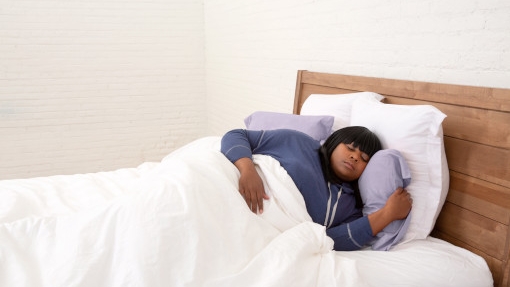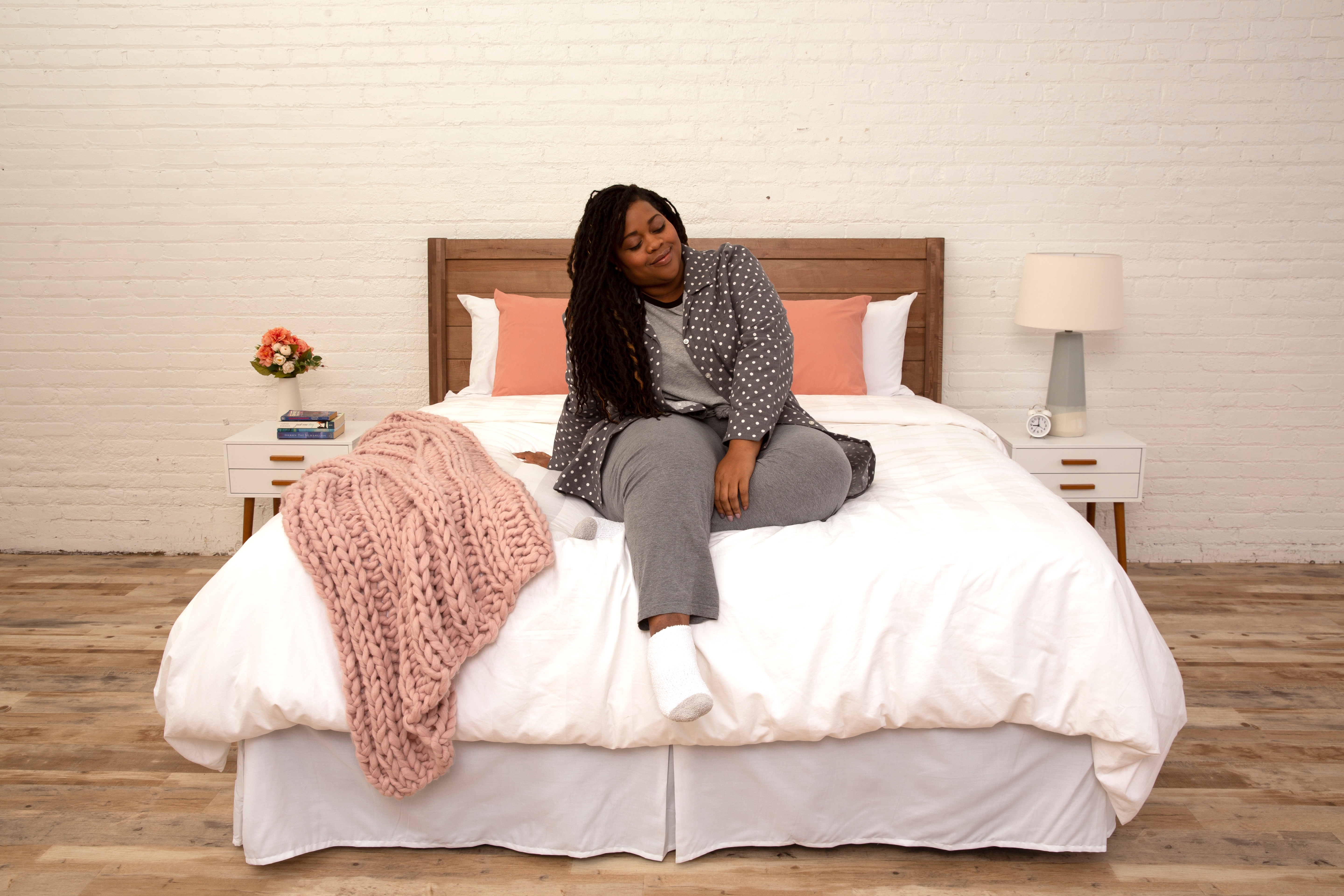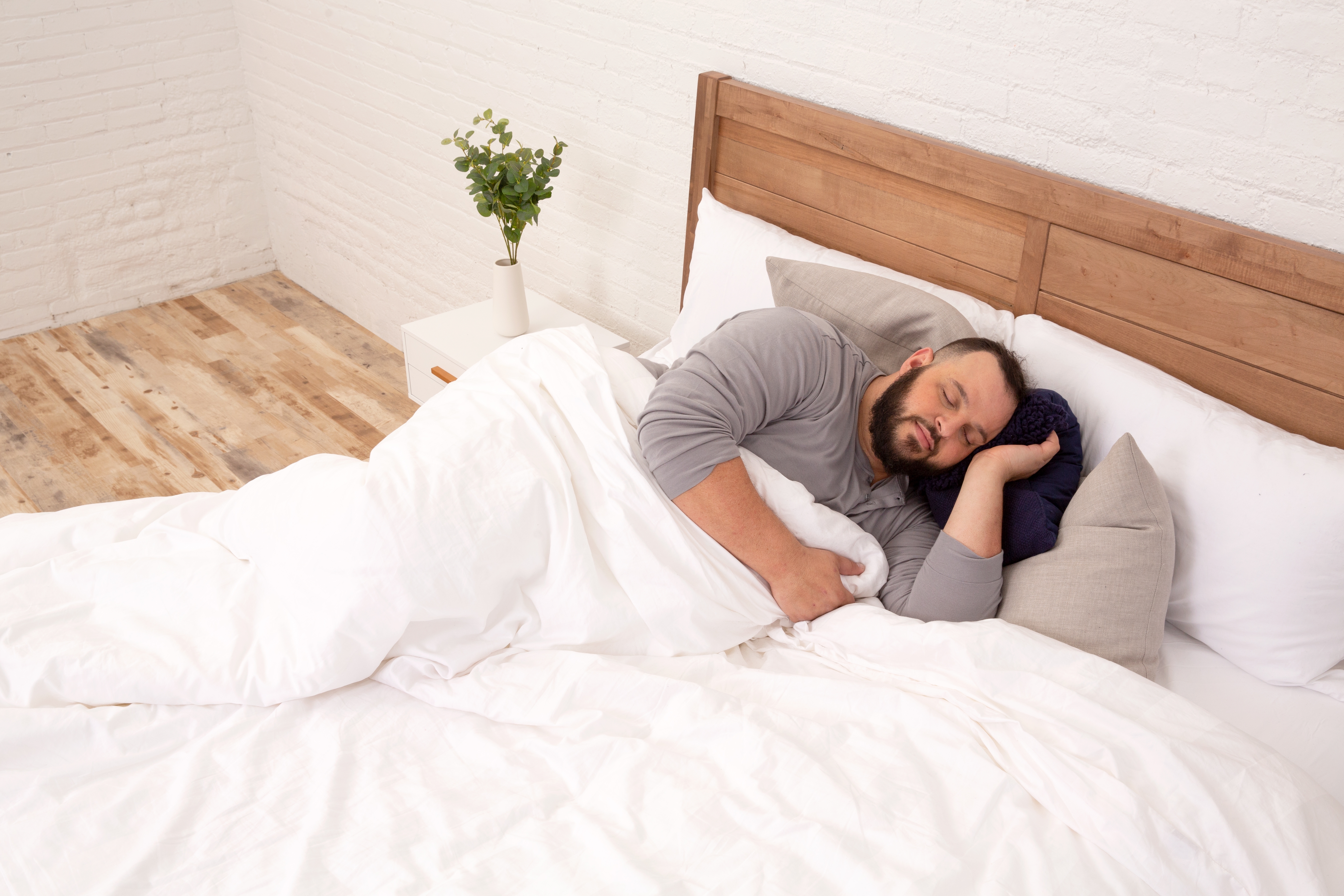If you're struggling with sciatica, you know how disruptive the pain can be to your sleep. Whether it's a burning sensation in your calf or electric-like pain shooting down your leg, it can be challenging to find a comfortable position.
Fortunately, a few simple dos and don’ts can help you snooze more comfortably while suffering from sciatic nerve pain . From light stretching to upgrading your mattress, here are some tips and tricks to help increase your comfort so you can sleep soundly each and every night.
What is Sciatica?
Ever heard of sciatica? It’s basically the pain you get when your sciatic nerve, the longest nerve in your body, decides to throw a tantrum. This nerve runs from your lower back, through your butt, and all the way down your legs to your feet. When it gets irritated, compressed, or inflamed, it can cause pain, numbness, or even a slight tingling in your lower back, legs, or feet.
It’s not just a little ache either — sciatica can range from mild discomfort to sharp, shooting pain that makes you want to stay in bed all day. It can happen for all sorts of reasons, like a herniated disc, spinal issues, or even muscle strain, and usually only affects one side of your body. So, if you’re feeling that familiar pain running down your leg, you’re probably dealing with sciatica!
Why is Sciatica Worse at Night?
Sciatica can feel worse at night because lying down increases pressure on the sciatic nerve. Without the distraction of daytime activity, you’re more likely to notice the pain, and your body may also be more prone to inflammation after a day of movement. Plus, when you’re resting, your muscles may relax, causing more irritation to the nerve. Basically, your body just doesn't have as much support when you're horizontal, making the pain feel worse.
What Causes Sciatica?
Sciatica can be caused by various factors, from everyday habits to specific health conditions. If you’re struggling with sciatica, you might find standing, sitting, or walking uncomfortable, and the pain can even make it hard to sleep. Stress can also worsen things by keeping you from getting a good night’s rest, intensifying the pain.
Here are some common causes:
- Herniated Disc: When the soft center of a spinal disc pushes out and presses on the sciatic nerve.
- Degenerative Disc Disease: Over time, the discs in your spine can wear down, putting pressure on the nerve.
- Spondylolisthesis: Occurs when one vertebra slips over another, pinching the sciatic nerve.
- Lumbar Spinal Stenosis: A narrowing of the spinal canal in your lower back that can crowd the sciatic nerve.
- Pregnancy: The extra weight and changes in posture can create pressure on the sciatic nerve.
- Obesity: Extra pounds can strain your lower back, leading to nerve compression.
- Lack of Exercise: Weak back and core muscles can contribute to nerve irritation.
- High Heels: Wearing them shifts your posture, putting more stress on your back. Sorry, runway models!
- Unsupportive Mattress: A mattress that's too soft can misalign your spine and worsen sciatic pain.
- Posture: If you have sciatica, it’s not just about the pain during the day — your body’s posture and rest habits play a significant role, too!
Best Sleeping Positions for Sciatica
How you sleep can either help or hurt your recovery, so let’s look at the best sleeping positions that help ease nerve pain while you snooze.
- On Your Back with a Pillow Under Your Knees: This position helps take the pressure off your lower back and sciatic nerve. Placing a pillow under your knees helps keep your spine in a more neutral, relaxed position.
- On Your Side with a Pillow Between Your Knees: Lying on your side with a body pillow tucked between your knees helps keep your spine aligned and reduces pressure on the nerve. This position is especially helpful if you have a herniated disc or spinal stenosis.
- Fetal Position: Curling up slightly in a fetal position can open up the spaces between your vertebrae, which relieves pressure on the sciatic nerve. Just make sure you’re not curling up too tightly!
Worst Sleeping Positions for Sciatica
A good night’s sleep can work wonders — unless you’re sleeping in a position that worsens your sciatica. Certain poses can add pressure to your sciatic nerve, making pain, numbness, and tingling even worse. Here are the ones to avoid.
- Sleeping on Your Stomach: This is probably the number one no-no for sciatica sufferers. Sleeping face down can twist your spine and put extra strain on your lower back, worsening nerve compression. It can also mess with your neck and cause even more pain.
- Lying Flat on Your Back Without Support: If you lie flat on your back without support for your knees, your lower back can arch, increasing pressure on your sciatic nerve. A pillow under your knees can help relieve the strain.
- Curled Up Too Tightly in a Ball: While the fetal position can help, curling up too tightly can actually make things worse. Being overly curled can put more pressure on your lower back and sciatic nerve, especially if you’re not using a pillow between your knees.
- Sleeping on One Side Without Proper Alignment: If you sleep on your side but don’t have a pillow between your knees, your top leg can pull your spine out of alignment, aggravating sciatic pain. A pillow can help keep your spine straight, improve body alignment, and reduce discomfort.
How Sciatica Affects Sleep & Why Sleep So Important
When we have a difficult time sleeping with sciatica, this lack of quality shut-eye hinders the natural process of recovery in our bodies, which, in turn, slows us down on our recovery from sciatica.
Sleep triggers the healing process, releasing hormones that regulate nearly every function in our body. That said, ensure everything in your sleeping environment supports restful sleep with sciatica for seven to eight hours each night.
Sleeping With Sciatica: The Dos’s and Don’ts
Ready to get some of the best shut-eye of your life? Here are some of the do’s and don’ts of sleeping with sciatica:
DO Create A Calm Sleeping Environment
Falling asleep with sciatica is much more tolerable when your room is dark, cool, and quiet. Try running a fan to stay comfy and drown out background noise. Add some lavender essential oils or sprays for a calming aroma that helps you drift off faster.
DO Elevate Your Knees
Elevating your knees can reduce pressure on your lower back for back sleepers. Place a pillow under your knees or use Big Fig’s Adjustable Base, which has pre-set positions to elevate your legs effortlessly. This simple adjustment can make a huge difference in your sleep quality.
DO Use A Neck Pillow
A good neck pillow can align your upper spine and reduce strain on your lower back. While fluffy pillows might feel cozy, they don’t offer enough support. Opt for a firmer pillow to keep your cervical spine in check and ease sciatica pain.
DON’T Sleep On Your Stomach
Sleeping on your stomach is a big no-no for sciatica. It forces your back to arch unnaturally, making the pain worse. If you can’t quit stomach sleeping, try placing a pillow under your stomach or pelvis to maintain a more neutral spine. Better yet, consider upgrading to a firmer, more supportive mattress like the Big Fig for the right balance of comfort and alignment.
DON’T Use Any Electronic Devices At Least 1 Hour Before Bedtime
Electronic devices, such as tablets and iPhones, emit a type of light called “blue light,” which affects a part of your brain that keeps you more awake. If we use these devices just before hitting the hay, our brain remains confused and doesn’t know whether to keep us up or let us snooze. This bad habit can further affect sciatica at night. If you take a long time to get comfy or drift off, that initially mild sciatica pain might turn into an incredibly painful episode.
DON’T Sleep On A Flimsy, Unsupportive Mattress
A saggy, unsupportive mattress is one of the worst things you can sleep on if you have sciatica. Without proper support, your spine can fall out of alignment, putting extra pressure on your sciatic nerve and worsening pain. That’s why the Big Fig Mattress is a smart choice for sciatica relief. Its hybrid construction combines soft foam layers for comfort and individually wrapped coils for sturdy support. It keeps your spine aligned and reduces stress on pressure points like your lower back and hips.
Unlike standard mattresses, which tend to sag over time — especially for those with fuller figures — Big Fig is built to last with high-density foam and reinforced coils that maintain firmness for years. Its ThermoGel Cooling® technology also helps regulate body temperature so you stay cool and comfortable throughout the night. For side sleepers or those who shift positions, the reinforced edges provide consistent support across the entire surface of the mattress.
Pair your Big Fig with our Adjustable Base, and you have a setup tailored for sciatica relief. Elevating your knees or adjusting your upper body helps take pressure off your lower back and promotes a neutral, pain-free posture. If your old mattress isn’t cutting it, Big Fig is your answer for quality, restorative sleep.
DON’T Sleep On Your Painful Side
For many individuals battling sciatica, one side may be more painful than the other. Sometimes, when we toss and turn at night, we end up on our more painful side. While staying in the same position all night can be challenging, try to prevent movement with a body pillow. Some sciatica pain sufferers even put a tennis ball in the pocket of their PJs to prevent them from rolling onto their painful side.
What Relaxes the Sciatic Nerve?
When sciatica flares up, relaxing the sciatic nerve is vital to easing pain and feeling like your old self again. The good news is that there are several ways to calm that nerve and soothe the surrounding muscles.
- Heat Therapy: A warm bath, heating pad, or hot shower can work wonders by loosening tight muscles around the sciatic nerve, reducing inflammation, and promoting better blood flow. Bonus points if you pair it with a bit of lavender or eucalyptus for extra relaxation.
- Stretching and Gentle Movement: Activities like yoga or targeted stretches for your lower back and hamstrings help reduce tension in the muscles that can compress the nerve. Focus on slow, controlled movements — no need to push too hard!
- Elevating Your Legs: Whether lying down with a pillow under your knees or lounging on an adjustable base (Big Fig has a great one!), keeping your legs slightly elevated can take pressure off your lower back and sciatic nerve.
- Relaxation Techniques: Deep breathing, meditation, or even light massage can help calm both your mind and your muscles, reducing stress that might make sciatic pain feel worse.
Tips To Relieve Sciatic Pain When Sleeping
If you’ve tried the usual remedies and still find yourself tossing and turning, don’t worry — there are more tricks up our sleeve to help ease that sciatic pain at night. Here are a few fresh ideas to consider:
- Invest in Weighted Blankets: Weighted blankets provide gentle, even pressure that can help relax your muscles and calm your nervous system. They can indirectly ease sciatic pain by helping your body relax throughout the night.
- Keep Movement Minimal: Tossing and turning can aggravate sciatic pain. If you’re restless, consider using a sleep positioner to limit movement and keep your spine aligned.
- Hydrate Beforehand (But Not Too Much): Dehydration can lead to muscle cramps and tension, which won’t do your sciatica any favors. Stay hydrated during the day, but avoid overdoing it close to bedtime to prevent late-night bathroom trips.
- Opt for Compression Therapy: Wearing a light compression wrap or sleeve around your lower back or legs can improve circulation and reduce nerve inflammation. Just make sure it’s snug but not too tight!
- Experiment with Mattress Toppers: If replacing your mattress isn’t in the cards just yet, a high-quality mattress topper can add an extra layer of support and comfort. The Big Fig Premium Plush Micro-Coil Topper combines responsive micro-coils and body-contouring high-density foam to relieve shoulder and hip pressure points.
- Incorporate Evening Relaxation Routines: Guided meditation or progressive muscle relaxation can help calm your nervous system before bed, reducing the likelihood of muscle tension and nerve irritation.
- Limit Heavy Meals Before Bed: Eating heavy or high-fat meals right before sleeping can cause inflammation, potentially worsening sciatica. Stick to light, anti-inflammatory snacks like cherries, walnuts, or herbal tea.
Bottom Line: Big Fig Mattresses Are the Best Mattress for Sciatica
Sleeping well with sciatica can be challenging, but it’s not impossible. While you might not eliminate the pain entirely, you can reduce symptoms enough for restful sleep. With the right strategies — and a supportive mattress like a Big Fig—you’re one step closer to waking up refreshed and pain-free.
Big Fig explicitly caters to sleepers with a bigger figure. Its hybrid construction combines high-quality springs and foam for unmatched support and comfort, making it an excellent choice for easing sciatica discomfort. Sleeping with sciatica takes patience and the right approach. Quality mattress aside, focus on supportive sleep positions and use pillows to ease pressure points. Incorporate relaxation techniques and set yourself up for success with a comfortable sleep environment. Don’t ignore your body’s signals or stick to habits that worsen your discomfort. Pain-free, restful nights are absolutely within reach with care and the proper setup!
Sources:
What Is Lavender? Possible Health Benefits, How to Grow It, and Best Sellers | Every Day Health
Slideshow How to Ease Sciatic Nerve Pain | WebMD
Blue light has a dark side - Harvard Health
The Big Fig Mattress is proudly endorsed by the American Chiropractic Association (ACA) for its exceptional quality, support, and design following a rigorous evaluation process conducted by an ACA review board of qualified doctors of chiropractic.







